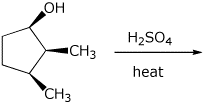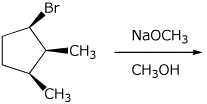|
|
Organic Chemistry I |
|
Professor Carl C. Wamser |
||
Exam 2 |
![]()
|
|
Organic Chemistry I |
|
Professor Carl C. Wamser |
||
Exam 2 |
![]()
1. (15 points) Write complete names for each of the following.
a) 
b) 
c) 
2. (15 points) Write accurate structures for the following:
a) the epoxide made from cis-2-butene
b) the Zaitsev product from dehydration of 2-methyl-2-hexanol
c) the most stable free radical of formula C5H11
d) the chlorohydrin made from isobutylene
e) one of the propagation steps in the chlorination of ethane
3. (15 points) Arrange each of the following in order
with respect to the property indicated.
Write “MOST” under the compound with the highest value and “LEAST” under
the compound with the lowest value.
a) bond strength
b) stability
c) relative rates of dehydration
d) stability
e) the earliest transition state (MOST = earliest)
4. (15 points) Complete the following reactions by indicating the major product expected. Show stereochemistry if it is specific.
a) 
b) 
c) 
d) 
e) 
5. (10 points) Show structures for all the different products expected
from the free radical chlorination of 2,2,3-trimethylbutane.
For an expected reactivity for H substitution of 3° > 2° > 1° in
a ratio of 5 : 4 : 1 , predict the relative amounts of each product expected.
6. (12 points) Use the compound shown below to illustrate the different products
that would result from all the possible cases of regiochemistry and stereochemistry
of addition.
H-Z represents some generic reagent that can add to the double bond, and
D represents deuterium or heavy hydrogen.

Markovnikov, anti addition
Markovnikov, syn addition
anti-Markovnikov, anti addition
anti-Markovnikov, syn addition
7. (18 points) The substitution reaction of tert-butyl alcohol with hydrogen iodide follows an SN1 mechanism with three steps. The approximate ΔH values for each step are indicated.
1) protonation of the alcohol (ΔH
= - 3 kcal/mol )
2) loss of water from the oxonium ion (ΔH = + 30 kcal/mol )
3) reaction of the carbocation with iodide (ΔH = - 20 kcal/mol )
Write
a potential energy diagram for this reaction that reflects these steps
and these ΔH values.
Label the axes and show the structures at each of the potential energy
minima.
Select ONE transition state that would be described as “late” and
draw its structure, illustrating what it means to be “late”.
Indicate where this transition state would be placed on the diagram.
![]()